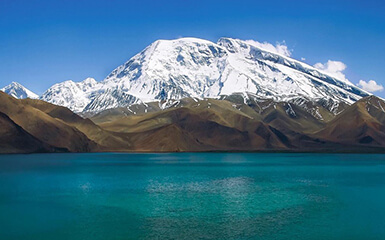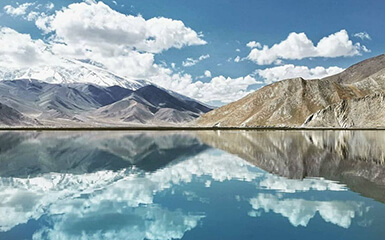Kok Gumbaz
Ajina Teppa
Ancient Panjakent
Anzob Tunnel
Beshkent Qala
Childukhtaron
Khazrati Shokh
Mug Teppa
Gharm Chashma
Hisor Historical
Haji Yaqub mosque
Hazrati-Bobo complex
Lake Iskanderkul
Kalai-Khumb
Karatag
Karon
Khishtin caravanserai
Khorog
Khulbuk
Lake Karakul
Abdullatif Sultan
Madrasai Kuhna
Abu Abdullah Rudaki
Khoja Mashhad
Khudoyor Valami
Makhmudi Azam
Mir Sayyid Ali Hamadani
Muhammed Bashoro
Sheikh Muslihiddin
Nurek Mountain Lake
Pamir
Sarazm
Sari-Khosor
Seven Lakes
Shirkent
Chiluchorchashma
Takht-i Sangin
Lake Karakul

Lake Karakul is the largest closed lake located in the eastern part of the Pamirs, south of the Trans-Alai Range, on the territory of the Gorno-Badakhshan Autonomous Region of Tajikistan. The name of the lake can be translated from Turkic as "Black Lake". It was named so because at a certain time of the day, the water in the lake acquires a black tint, although this is not entirely reliable: when the sun shines at a certain angle, the clear water of the lake becomes either dark blue or dark green.
The lake lies in a flat basin at an altitude of 3914 meters above sea level. Karakul is 100 m higher than the famous high-mountain Lake Titicaca in the Andes. In addition, this largest glacial-tectonic lake has an area without islands of 380 square kilometres, and a maximum depth of about 240 meters. Desert rocky ridges, approaching the lake in the west, and several kilometres away from it in the east, surround karakul.
The bitter-salty lake water remains cold almost all year round. In winter, the lake freezes over. In the warm season and in calm weather, the water of Karakul is absolutely transparent, but with a strong wind waves rise, and the colour of the water becomes dark. The shores of the lake are surrounded by high mountains on three sides, and only on the eastern side, it opens onto a small picturesque valley. The views opening up to the traveller descending into the valley from the Kyzylart pass are especially charming. The possibilities for mountain climbing in the lake region are unlimited.
The small rivers Kara-Dzhilga, Karaart, Muzkol and several smaller rivers flow into Karakul, but not a single one flow out, which turns the lake into an endless one. The water here has a bitter-salty taste, the percentage of salt per litre of water here is quite high, which is why the lake acquired the glory of the dead. At the mouth of small rivers flowing into the lake, where the water is more or less fresh, there are few loach fish. Colonies of brown-headed gulls and Tibetan terns nest on the islands.
On the eastern shore of the lake, not far from the highway, there is the village of Karakul, the main population of which is Kyrgyz. Moreover, a few kilometres from the lake is the famous Markansu Valley. The world famous Stone Age site of Oshkhon (eighth millennium BC), the habitat of seasonal hunters, was discovered here. In the area of the village of Karaart, located about a kilometre from the Murghab-Osh highway, at an altitude of 3950 m, there is an architectural complex of the middle of the first millennium, which combines the observatory with the cult of animals.

